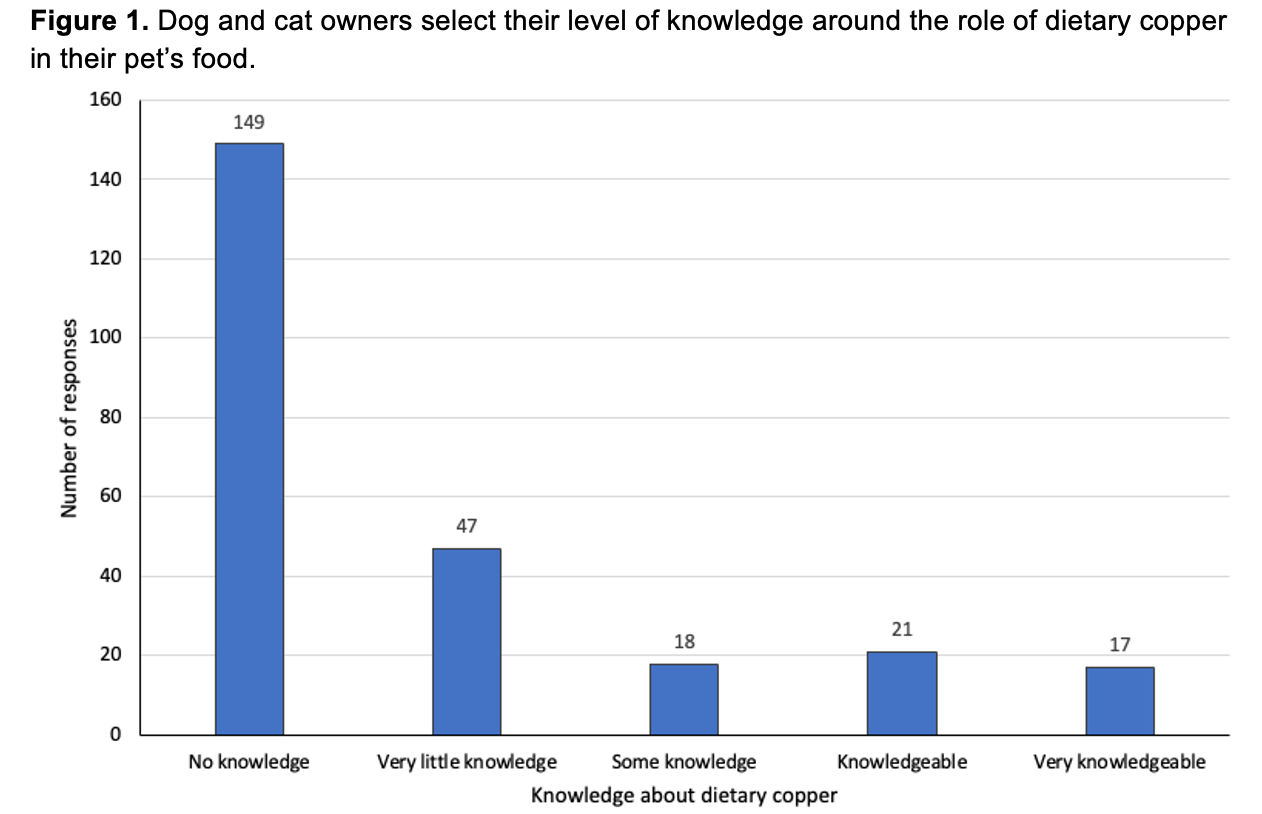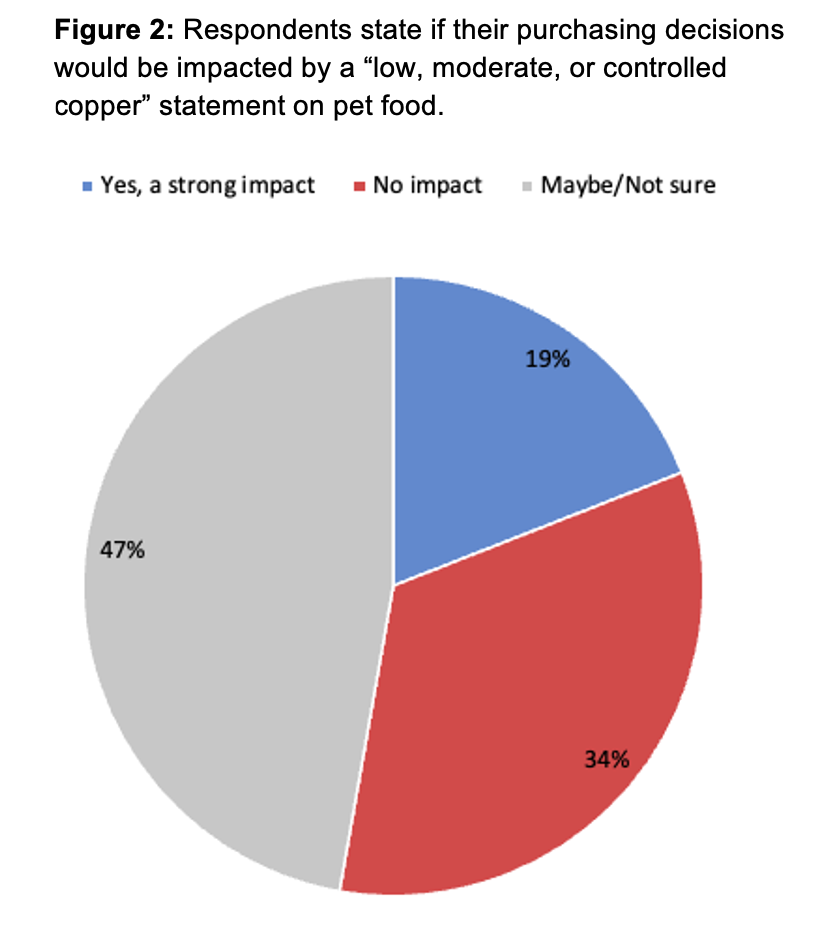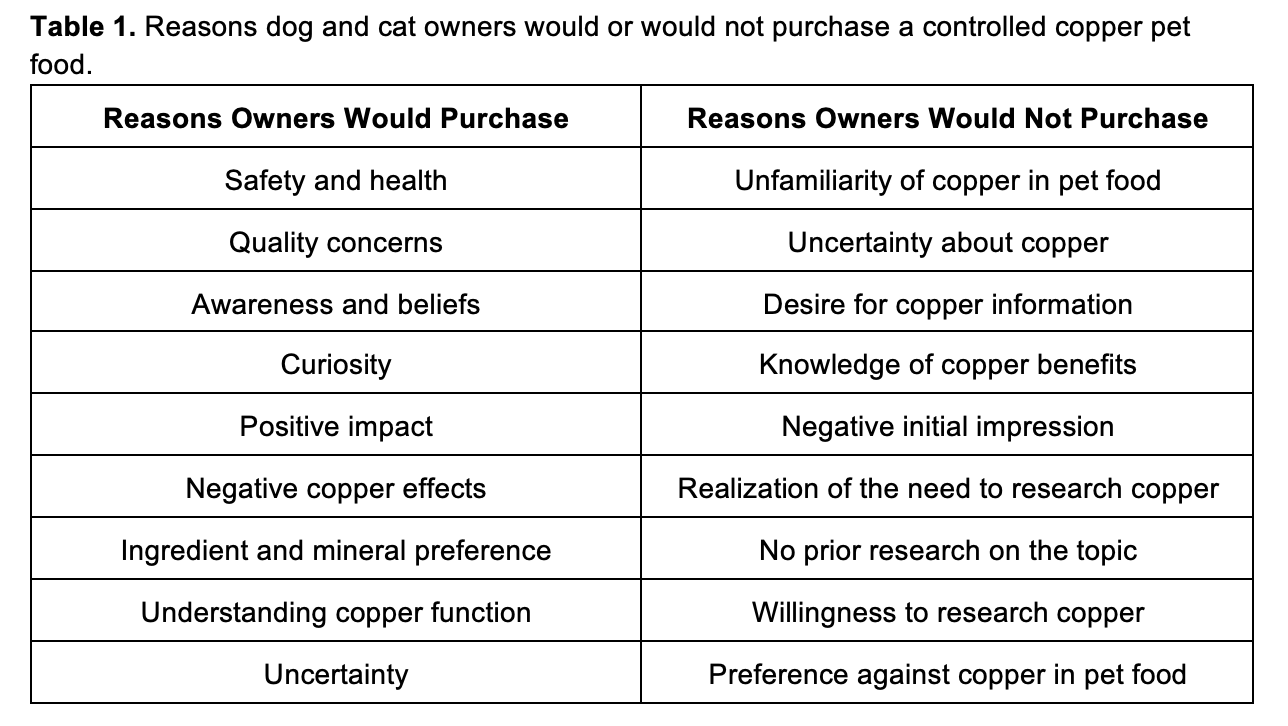Photo: Capricorn/Adobe Stock

Editor’s Note: The authors are affiliated with Hill’s Pet Nutrition.
Copper is an essential nutrient for dogs and cats and is involved in a variety of biological functions. To prevent copper deficiencies in diets for dogs and cats, the Association of American Feed Control Officials (AAFCO) recommends a minimum copper, but not a maximum concentration in pet foods.1 In turn, concerns have been raised about the potential for copper toxicity in dogs and cats.2
AAFCO assembled a panel of nutrition experts who investigated the matter and found insufficient evidence to recommend a maximum. However, an option is proposed to consider establishing a standard for low or controlled copper diets.2
In response to AAFCO, a survey was conducted by the authors of this article to investigate pet owner awareness of dietary copper in pet food, and the impact of a claim of “low, moderate, or controlled copper” in their purchase intent.
To understand the impact of pet food claims on pet food purchasers and their impact on veterinary medicine, the authors of this article investigated pet owner awareness of dietary of copper in pet food and the effect a claim of “low, moderate, or controlled copper” has on their purchase intent through a recent survey. Sponsored by Hill’s Pet Nutrition, the survey used a blinded third party research platform.
Methodology and participant data
Across the United States, 2877 pet owners were invited to join an internet community panel. Panel enrollment qualifications require individuals to be 18 years of age or older and own a dog or cat. Among all pet owners on the panel, there was a fairly even split between men and women with the majority between the ages of 25 and 54 years. Also, 48% of the panel members reside in the Southern region while the rest are split between the West, Midwest, and Northeast regions of the US. Panel members live in suburban (42%), urban (32%), and rural (26%) areas. More than half of the pet owners in the panel have a dog and/or a cat in their household. Of the total participants invited to participate in the online activity, 252 dog and cat owners completed the survey.
Scope of Survey Questions
Participants were asked about their familiarity with copper and why it is added to pet food. Then, they were asked what certain claims about copper meant and how it might affect their pet food buying habits. Notable questions and answers are as follows:
Knowledge of the role of dietary copper in pet food
Most respondents (78%) said they had little (n=47) or no (n=149) knowledge about the role of dietary copper in pet food (Picture 1). Although the majority of pet owners (94%) disagreed that dietary copper is an important nutrient and requirement in pet food, many respondents indicated that they did not fully understand that copper is an important nutrient that should be part of a balanced diet. The majority of respondents chose a ‘moderate’ or ‘neutral’ feeling on the inclusion of copper in a complete and balanced diet.
All photos courtesy of Hill’s Pet Nutrition.

The role of dietary copper in purchasing decisions

Of those surveyed, 51% of pet owners reported being “unsure” about a “low, moderate, or controlled copper” claim on packaging. However, 47% of these individuals indicated that their purchase decisions could be affected by a “low, moderate, or controlled copper” statement. Only 19% of these pet owners would be affected in their purchasing decisions by the same statement. Overall, the majority of consumers (66%) will make feeding decisions based on a negative claim that they do not understand (Figure 2).
Pet owners were also asked whether they would buy pet food with one of these claims: “Low copper”, “Moderate copper”, or “Controlled copper.” Based on their individual responses, a follow-up question asked why they would or would not buy pet food containing copper.
Respondents willing to purchase copper-regulated foods (22%) cited a variety of reasons for doing so including safety and health purposes, quality concerns, nutritional knowledge, and general beliefs (Table 1). On the contrary, the owners who reported that they would not buy a controlled copper food (13%) said that they were not familiar with this topic and had a desire for more knowledge.

Perceived benefit or lack of copper levels
Survey participants were also asked whether the terms “low copper”, “moderate copper”, or “controlled copper” made them think there was an advantage or disadvantage compared to a food with normal levels of copper, and whether they will avoid pet food that does not have a “low, moderate, or controlled copper” claim. Of the respondents, 28% said they felt there were benefits to a copper controlled food, and 57% were unsure if there was an advantage or disadvantage, while 22% indicated they would avoid buying pet food that no “low, moderate. , or controlled copper” statement.
These statements show ambiguity in understanding the role of copper in pet food. However, the statements also show polarized feelings about how these claims will drive consumers toward and against a product with these claims.
Conclusion
Overall, these results indicate that pet owners are more influenced by nutrition claims in pet foods, even if they are not familiar with a particular nutrient. These insights suggest that some claims are prompting dog and cat owners to seek further education about the role of dietary copper, and potentially other nutrients, in pet food and release concerns over the role of claims and negative bias in nutrition.
Additionally, these results support the American Veterinary Medical Association’s position not to support copper claims in an over-the-counter diet, and the decision to feed a reduced copper or other component Diet adjustments should be made in consultation with a veterinarian.3 Further investigation is needed to understand if, and to what degree, owners choose these product marketing claims to make purchase decisions, self-diagnose their pets, or try treat dogs with known liver disease.
Author Leslie Hancock, DVM is chief medical officer for Hill’s Pet Nutrition in Topeka, Kansas. Author Laura A. Motsinger, PhD, is senior scientist-global clinical nutrition and claims for Hill’s. Author Madison D. Amundson, BS, is an associate scientist for Hill’s.
Sources
- Feed control officials re-imposed copper concentration guidelines. dvm360. April 18, 2023. Accessed March 13, 2024. https://www.dvm360.com/view/feed-control-officials-reassert-copper-concentration-guidelines
- Center SA, Richter KP, Twedt DC, Wakshlag JJ, Watson PJ, Webster CRL. Is it time to reconsider the current guidelines for copper content in commercial dog foods? J Am Vet Med Assoc. 2021;258(4):357-364. doi:10.2460/javma.258.4.357
- Copper in Dog Foods Expert Panel: Final Report with Recommendations to the Pet Foods Committee. Association of Animal Feed Control. 2022. Accessed March 13, 2024. https://www.aafco.org/wp-content/uploads/2023/01/Copper_in_Dog_Foods_Expert_Panel_Report_to_the_PFCkv2136684-2136685.pdf


